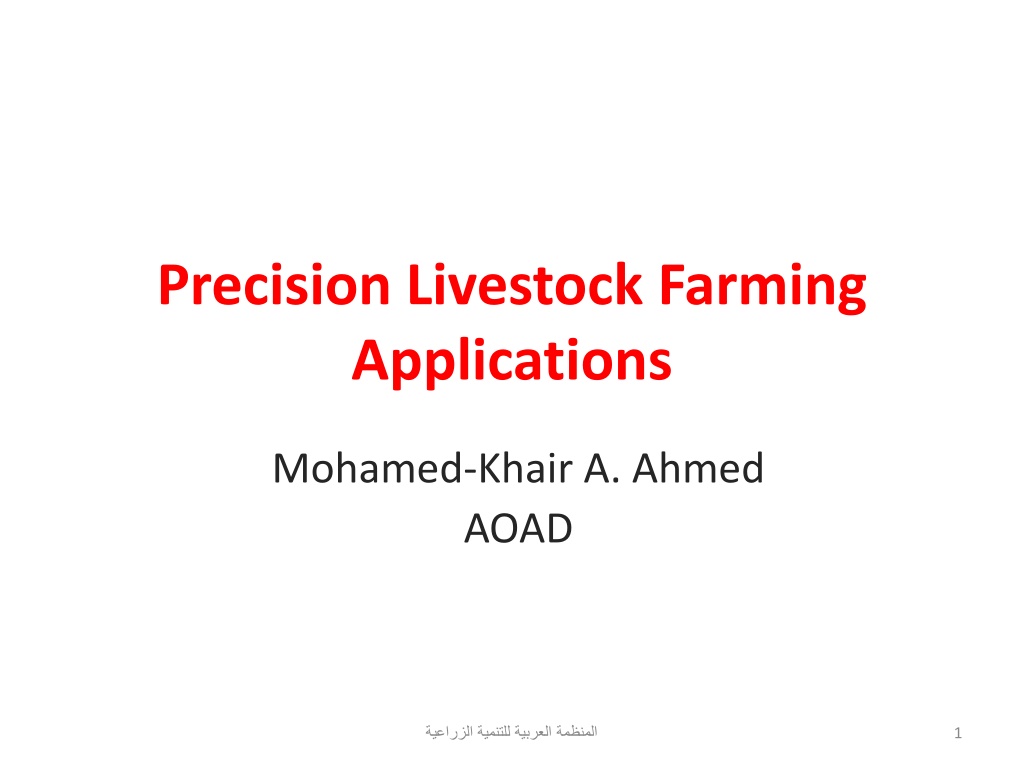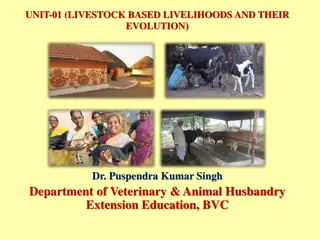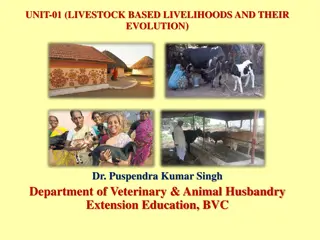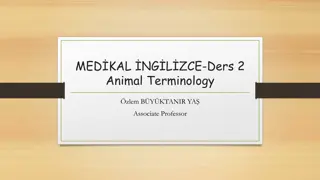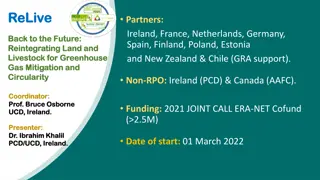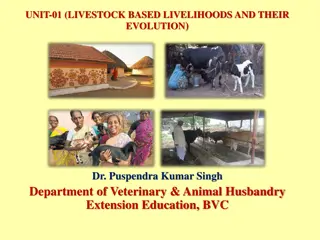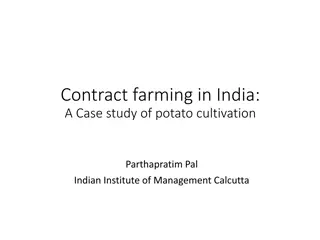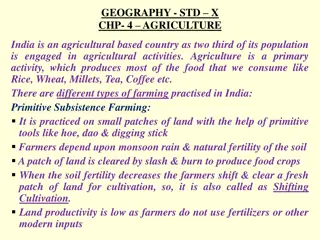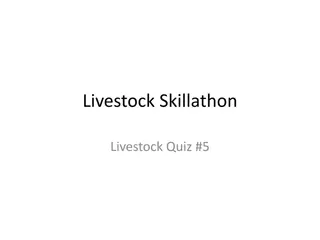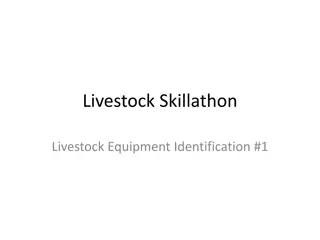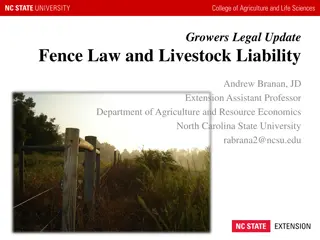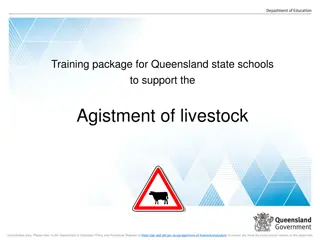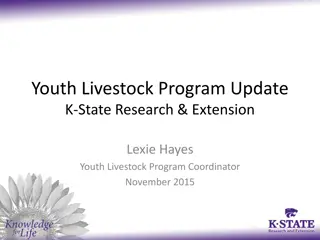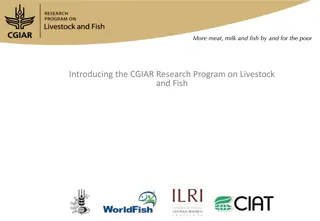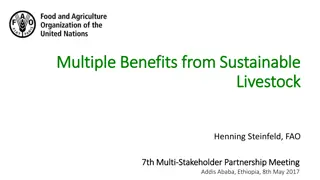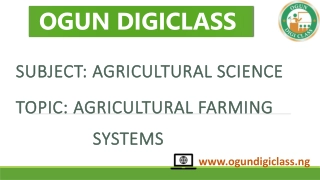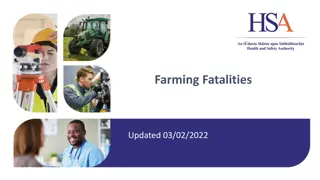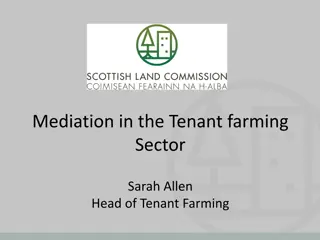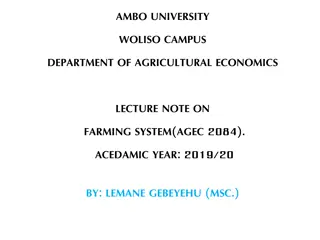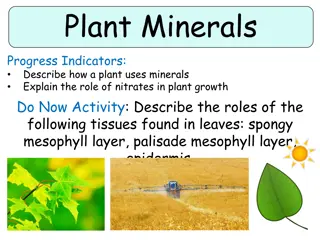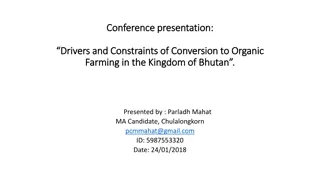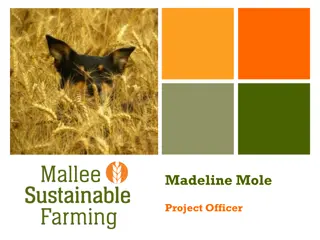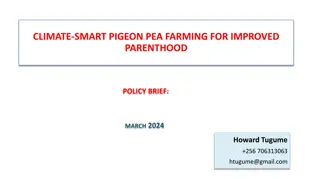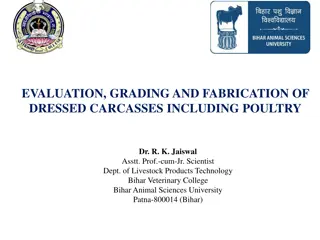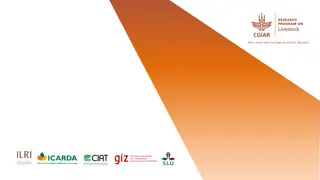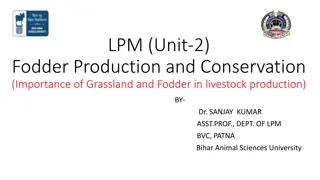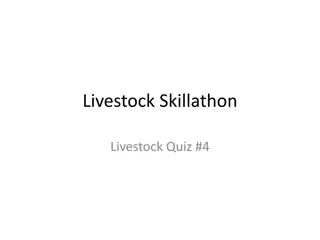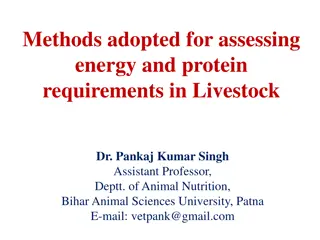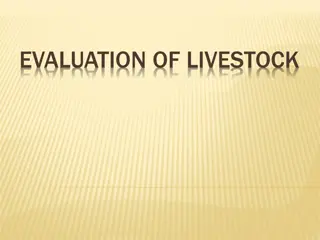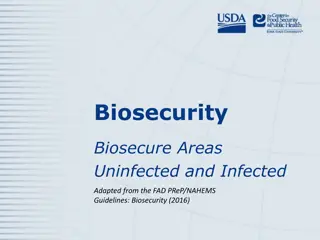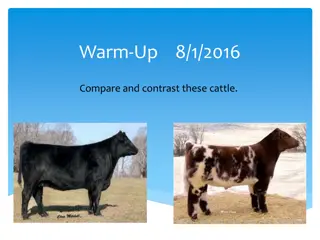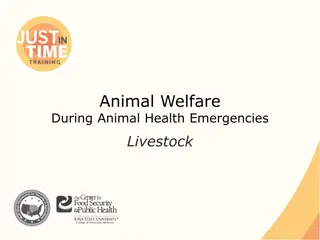Advancing Livestock Farming Through Precision Technology
Precision Livestock Farming (PLF) utilizes automated real-time monitoring to enhance production, reproduction, health, and welfare of animals. By measuring animal and environmental variables, utilizing predictive models, and integrating data for decision-making, PLF offers benefits such as improved animal welfare, reduced greenhouse gas emissions, economic stability, and traceability within the food chain. It also enables more efficient resource utilization, early disease detection, environment management, and enhanced phenotyping for selection and genomic deployment in livestock farming.
Download Presentation

Please find below an Image/Link to download the presentation.
The content on the website is provided AS IS for your information and personal use only. It may not be sold, licensed, or shared on other websites without obtaining consent from the author. Download presentation by click this link. If you encounter any issues during the download, it is possible that the publisher has removed the file from their server.
E N D
Presentation Transcript
Precision Livestock Farming Applications Mohamed-Khair A. Ahmed AOAD 1
What is PLF? Management of livestock farming by automated real-time monitoring/improving of production/ reproduction, health and welfare of livestock. It may also be defined as: The use of information and communication technologies for improved control of fine-scale animal and physical resource variability to optimize economic, social, and environmental livestock farm performance 2
Steps in PLF application Measurement and continuous analysis of animal-variables using sensors. These variables include: live weight, ingested food quantity, feeding behavior (ingestion, mastication, rumination, frequency of mouthfuls), and social behavior. Physiological parameters (body temperature and pH, milk composition. Measurement and recording of environmental variables in stable (Temp, humidity, .) 3
The use of a reliable predictive model of animals reactions to environmental conditions (diet, climate, farming practice). Compare animal reactions provided by sensors with those expected based on the mathematical model to identifiy problems requiring farmer intervention. The predictive model and the sensors measurements are integrated into an algorithm to help farmers to take decisions. 4
Benefits of PLF Improvement in animal welfare/production Reduce greenhouse gas (GHG) emissions Improve the economic stability of rural areas. Reduce manual workload for the farmer such as livestock feeding and general health monitoring Complete traceability of livestock through the food chain. It can play an important role as a traceability system throughout the entire production process, which is an essential requirement for accessing international markets. 5
Efficiency: More efficient use of resources and reduction of harmful emissions per unit of product (precision feeding) Diagnosis: Reduction of the use of drugs through early detection of pathologies. Prevention: Management of environment in livestock housing Phenotyping: High throughput phenotyping for selection on new characters (robustness) and deployment of genomic selection 6
Factors limiting adoption Availability of information, awareness, training In developing countries: Cheap labour, lack of funds for investment. Lack of infra structures (Broad band internet, animal EID, ). Equipments and programs under development 7
Climate smart PLF Smart agriculture in a changing climate is a tool to guide actions to transform and reorient agricultural systems to support development effectively and guarantee food security in a changing climate. It has three main objectives: Realize sustainable increase in incomes and agricultural productivity Adaptation and improved resilience for climate change Reduce or eliminate GHG emissions where possible 8
Climate smart PLF The livestock sector uses one third of global arable land and 8% of available freshwater. It is also largely responsible for deforestation and biodiversity loss, and contributes 15% of global CO2 emissions compared with 13.5% by all transport systems. As population and incomes continue to increase, demand will also increase Consequently, the objective for the livestock sector must be to fulfill future demand, ensure consistent quality, and to achieve this in a sustainable manner without causing environmental damage or depleting resources. 9
Effect of climate change on livestock Livestock production is affected by climate change in four ways: a) The availability and price of feeds, b) The effect on pastures and forage crop production and quality, c) Changing distribution of diseases and pests. Increased spread of existing vector-borne diseases and parasites, the emergence of new diseases. d) The direct effects of weather on animal health, welfare, growth and reproduction. Heat stress directly impairs production. 10
The importance of biodiversity Biodiversity of farm animals can help provide food security under climate change. It can allow the modification of production systems to meet future challenges. There are variable roles and values of animal genetic resources particularly for poor rural people. There is need for better understanding of the adaptation of species and breeds to specific environmental challenges such as high temperature, limited water and poor feed quality. New trends in the livestock sector affect animal genetic resources. Intensive production, increased pressure on natural resources 11
Solutions Breeding more productive animals and conserving livestock diversity. Improving diets so that animals produce more protein with less feed and lower emissions Better manure management (e.g. composting) Better herd management to improve output, including better herd health with less reliance on antibiotics Better management of grassland (e.g. sowing improved varieties of pasture, rotational grazing) 12
Breeding more productive livestock: There is need for adoption of breeding and conservation programs Efforts by AOAD: Farmers in Sudan adapt production system to climatic conditions. a. Introgression of booroolla gene in Hamari ecotype. b. Selection for growth rate Use of crossbreeding: Sudan experience 13
Examples of PLF systems include: Precision feeding systems: feeding systems allow farmers to feed their cows accurately, precisely and with minimal expenditure of work at all times. Precision milking robot: a good example of large adoption of PLF systems are automatic milking machines. These robotic systems can handle up to 65 cows on an average of 2.7 times per day. Stable and farm management systems: various PLF support and monitoring systems exist, which use cameras and microphones and thus act as the eyes and ears of the farmer at all times. 14
Applications in beef production Livestock is already one of the most demanding sectors in terms of resource use and emission intensities One third of global cropland is dedicated to feed crop production Over 13 billion tonnes of manure are produced per year, which requires a considerable amount of agricultural land to apply it on. Population and incomes continue to grow, there will also be large increases in demand for meat. The objective for the sector must be to fulfill future demand, ensure consistent quality, and achieve this in a sustainable manner without causing environmental damage or depleting natural resources 15
Applications in beef production The monitoring of the growing herd where measurement of growth in real time is important to provide producers with feed conversion and growth rates. Hierarchy within the herd determines priority of access to limited resources, resulting in stress to the lower ranking cows. Identifying these cows may enable the breeder to improve grouping management and minimize stress. This will lead in turn to improved production and lower replacement costs Detection and monitoring of diseases and aspects related to animal behaviour and the physical environment such as the thermal micro environment and emissions of gaseous pollutants. 16
Monitoring the physiological status of the animal Imaging systems to avoid direct contact with animals. Greater efficiency can be achieved if inforation collected through the supply chain is shared amon stakeholders (Vets, slaughter houses, meat processors., feed mills) 17
PLF in Dairy Farming Potential to provide continuous monitoring of performance and analysis. Automatic sensors for monitoring udder health, milk production, reproductive status, feed intake, BW changes etc. Provide continuous detailed information about each cow. efficient utilization of feed and nutrients early warning of bad health and reduced drug use. reduction in pollutant emission... 18
Sensors All kinds of Milk constituents. Eating behavior, Respiration rate, Rumination, chewing behavior, Stress responses, Deep body temperature, Body weight, Udder health, Oestrus, Breath emissions, Biting rate in grazing cows, Lying behavior, Weight, Lameness, Activity etc.... Measure motion (accelerometers, gyroscopes) Location (GPS/GNSS) Direction (magnetometers) Height & density of pasture (Active Optical Sensors) Temperature, soil moisture 19
The dairy cattle PLF elements usually comprise: a robust, high node count sensor network with a neck mounted collar engine gathering activity data from individual animals A cloud based software environment that manages on-farm data and pro-actively alerts the farmer, real time of key operational and management interventions 21
An electronic unit housed in a collar around the neck of the cow, records neck and muscle movements continuously . The data is processed on-collar using advanced software and the data is downloaded to a PC wirelessly whenever a cow enters the receiving area of a base station. Each collar has a model of normal behaviour patterns and alerts the farmer of cow conditions only when there is need for intervention 22
Automatic milking systems Each cow is fitted with a unique electronic identification that allows the cow to be recognised electronically at gates and in the milking unit. A robotic arm cleans the teats, attaches the milking cups and sprays the teats of each cow. Each quarter is milked individually and cups are removed based on the milk flow from each teat, thereby minimising overmilking of each quarter. Most automatic milking systems have the capacity to feed grain-based concentrate at each milking. 23
Poultry PLF measures the response of the birds by means of feed and water intake sensors, bird weight sensors, cameras that monitor bird activity and microphones that check noise levels and patterns. A number of systems are used to monitor problems in a poultry house such as disease incidents, climate control, failures of feeder lines, electricity problems and water lines. The system depends on a number of cameras in the roof that show the distribution of birds/m2. This is compared with normal distribution for time of day and farmer is alerted when there is a difference of 25%. 24
PLF in the Arab region Arab countries with significant numbers of livestock (Sudan, Somalia, Mauritania) have problems that hinder PLF applications: The pastoral system of production does not allow animal identification. Poor infrastructures (Broad transport, ). The cost of monitoring systems. However, some PLF applications are possible particularly in range management, large dairy farms and poultry production companies band internet, 25
Baladna, Qatar Ventilation system comprised of industrial quality, high- volume fans, high/low pressure misting and cow soaking system with integrated control system 26
The Future Extension to improve awareness of the possibilities of PLF Better availability of low cost monitoring gadgets (cameras, microphones,EID). Need for support of research at universities and research stations 27
